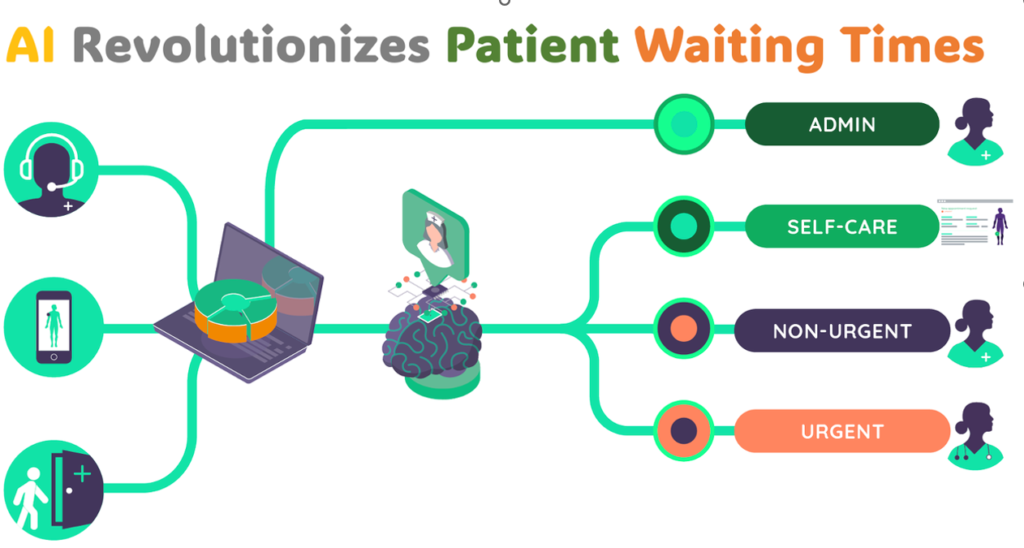Revolutionizing Healthcare: AI and ML Solutions to Transform Patient Wait Times
Revolutionizing Healthcare: AI and ML Solutions to Transform Patient Wait Times
Introduction:
In the intricate web of healthcare systems around the world, one challenge persists as a thorn in the side of both providers and patients alike: long wait times and patient flow problems. The frustrations are real, the inconveniences undeniable, and the consequences are far-reaching.

The Culprits Behind the Waiting Game:
1.Increased Demand for Healthcare Services: The world is aging, and people are living longer, which means a surge in demand for healthcare services. This demographic shift is pressuring healthcare systems to accommodate a larger, often more complex patient base.
97% of patients have reported frustrations from waiting too long to see a doctor.[1]
2.Shortage of Healthcare Providers: The shortage of healthcare providers, including doctors, nurses, and other professionals, is a critical factor contributing to these challenges. Recruitment and retention struggles and the retirement of experienced staff make this shortage even more acute.


3.Inefficient Healthcare Systems: Inefficiencies within healthcare systems, like redundant paperwork, fragmented data sharing, and convoluted administrative processes, add to the wait times. Streamlining these systems is a necessity for improved patient flow.
The median U.S. emergency room wait time is 2 hours 40 minutes. [2]
4.Lack of Coordination Between Healthcare Providers: Patients often need to see multiple healthcare providers for a single condition or treatment plan. Lack of coordination among these providers can lead to fragmented care, duplicated services, and prolonged wait times for patients.
An estimated 80% of serious medical errors involve miscommunication between providers.[3]
The Domino Effect of Long Wait Times:
The consequences of long wait times and patient flow problems are more than just inconvenient—they’re consequential:
1.Patient Dissatisfaction: As wait times extend, patient dissatisfaction escalates. Frustration with delays can lead to a lack of trust in the healthcare system.
2.Decreased Access to Care: Prolonged wait times become barriers to timely care, especially for patients with urgent or chronic conditions. Delayed care can worsen health issues and lead to poorer outcomes.
Wait times for doctor appointments in the U.S. average 26 days. [4]
3.Increased Costs: Patients forced to wait may resort to emergency room services or experience deteriorating health conditions. These scenarios jack up healthcare costs, placing an additional burden on the system.
Delayed or canceled surgeries due to waiting times cost the U.S. healthcare system an estimated $22.3 billion. [5]


Hope on the Horizon: Solutions to Improve Patient Flow
1.Increase the Number of Healthcare Providers: Tackling the provider shortage demands investment in education, training, and the removal of barriers preventing healthcare professionals from practicing across regions or countries.
2.Improve Healthcare System Efficiency: Technology holds the key to enhancing communication and coordination among healthcare providers. Electronic health records (EHRs) and telemedicine can streamline processes and save valuable time and resources.
3.Enhance Coordination Between Healthcare Providers: Integrated care models are the future, where patients receive comprehensive care from a cohesive team of providers in one location. This approach promises to streamline the patient journey and reduce frustrating wait times.
AI and ML: The Game Changers in Healthcare Efficiency
But here’s where the revolution truly begins. Artificial Intelligence (AI) and Machine Learning (ML) have stepped onto the healthcare stage, armed with the potential to transform patient wait times and streamline the entire healthcare ecosystem:
Resource Optimization:
CloudAstra’s algorithms can optimize appointment scheduling, resource allocation, and staff management. This ensures that providers are in the right place at the right time, minimizing patient wait times.
Predictive Analytics:
CloudAstra’s AI and ML algorithms can analyze vast amounts of patient data to predict demand patterns. This enables healthcare providers to allocate resources more efficiently, reducing bottlenecks and wait times.
AI-driven predictive analytics can reduce patient wait times by up to 50%.[6]
Understanding the Current Landscape:
Hospitals worldwide deal with a myriad of challenges daily. ER surges, extended patient wait times, inter-department bottlenecks, and inconsistent patient experiences are common issues. Traditionally, these problems have been tackled reactively through historical data analysis. However, CloudAstra recognizes the need for a proactive approach.
Predicting and Managing ER Surges:
One of the most critical aspects of efficient patient management is predicting and addressing Emergency Room (ER) surges. CloudAstra’s AI/ML engine employs real-time data analysis to predict when ER surges are likely to occur. By doing so, hospitals can allocate resources efficiently, ensuring that patients receive timely care even during peak periods.
Real-Time Monitoring of Patient Wait Times:
Patient wait times have a significant impact on both patient experience and overall hospital efficiency. CloudAstra’s solution continuously monitors patient wait times and provides real-time reports to healthcare professionals. This enables them to make informed decisions, optimizing patient flow and minimizing wait times.
Optimizing Patient Routes:
Imagine a system that can suggest alternate routes for patients based on imaging and lab wait times. CloudAstra’s AI/ML engine does just that. By considering various factors, including the patient’s condition and the workload in different departments, the system suggests the most efficient route, reducing delays and improving overall patient experience.
Seamless Inter-Department Coordination:
Inter-department bottlenecks can significantly impact patient flow within a hospital. CloudAstra’s Patient Throughput module acts as a coordinator, facilitating seamless admissions from the ER to inpatient departments. This not only clears bottlenecks but also ensures that patients receive the right care promptly.
Empowering Staff with Real-Time Insights:
Healthcare professionals are the backbone of any hospital, and their decisions directly affect patient experience. CloudAstra’s AI/ML engine provides real-time suggestions and alerts to staff, enabling them to make informed decisions quickly. This not only improves patient care but also reduces the burden on staff, making their work more efficient and less stressful.

A Brighter Future for Healthcare:
In the ever-evolving landscape of healthcare, addressing long wait times and patient flow issues is paramount. By tackling root causes, investing in the healthcare workforce, and embracing innovation—particularly AI and ML—we can pave the way for a healthcare system that provides equitable access to quality care.
Conclusion:
CloudAstra is at the forefront of this transformation, with an unwavering focus on improving efficiency and enhancing patient experiences through AI and ML. As we navigate the path toward better patient flow and reduced wait times, these innovations bring us one step closer to a healthier, happier future in healthcare—a future where technology doesn’t just alleviate the challenges but also revolutionizes the entire patient experience.
Sources:
- Weber, Steph. “Enhancing the Patient Experience with Exceptional Customer Service.” Physicians Practice, 9 Jan. 2017, https://www.physicianspractice.com/view/enhancing-patient-experience-exceptional-customer-service.
- Fitzpatrick, A. (n.d.). Hospital staffing shortages are leading to longer er visit times. Axios. https://www.axios.com/2023/09/15/hospital-er-visit-time-length
- Riesenberg, Lee Ann. “Shift-to-Shift Handoff Research: Where Do We Go From Here?.” Journal of graduate medical education 4,1 (2012): 4-8. doi:10.4300/JGME-D-11-00308.1,https://www.ncbi.nlm.nih.gov/pmc/articles/PMC3312531/.
- “2022 Survey of Physician Appointment Wait Times.” Merritt Hawkins, https://www.merritthawkins.com/trends-and-insights/article/surveys/2022-physician-wait-times-survey/.
- Bose, Sourav, and Serena Dasani. “Hospital Revenue Loss from Delayed Elective Surgeries.” Penn LDI, 16 Mar. 2021, https://ldi.upenn.edu/our-work/research-updates/hospital-revenue-loss-from-delayed-elective-surgeries/.
- Li, Xiaoqing et al. “Artificial intelligence-assisted reduction in patients’ waiting time for outpatient process: a retrospective cohort study.” BMC health services research 21,1 237. 17 Mar. 2021, doi:10.1186/s12913-021-06248-z, https://www.ncbi.nlm.nih.gov/pmc/articles/PMC7966905/
Contact Us
Let us innovate together. If you are interested in exploring this further contact us at https://cloudastra.ai/contact-us

